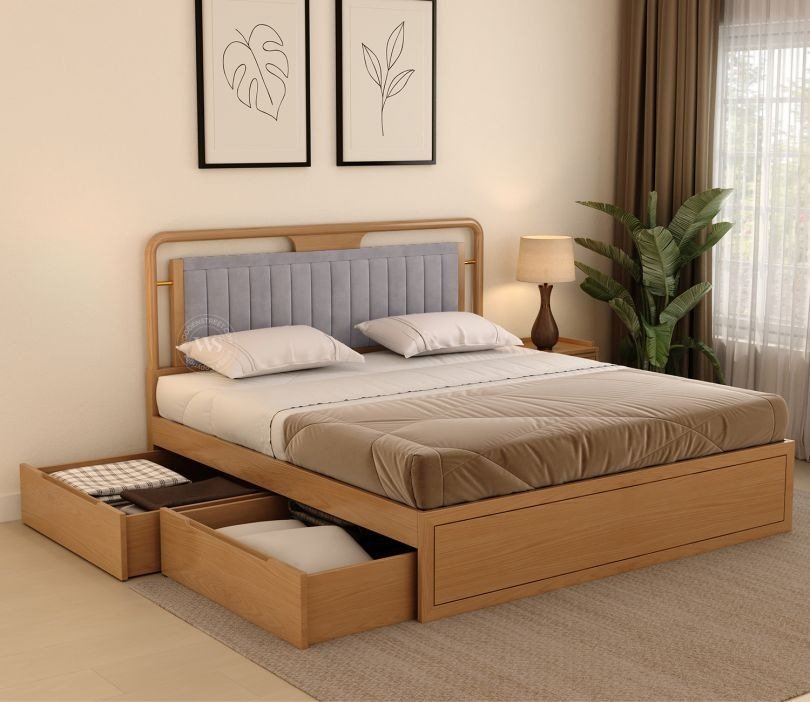When it comes to bedroom furniture, a king size bed is the ultimate symbol of comfort, luxury, and spaciousness. However, many people hesitate to choose one because they believe it won’t fit in a small or medium-sized bedroom. The truth is, with smart space planning, clever furniture choices, and strategic layouts, you can enjoy the comfort of a king bed without compromising the flow or functionality of your room.
In this guide, we’ll cover practical space-saving tips, storage solutions, and design strategies to help you fit a king size beds design perfectly into smaller spaces while maintaining both style and comfort.
Understanding the Dimensions of a King Size Bed
Before planning, it’s important to know the standard size of a king size bed.
- Standard King Size Bed: Around 76 inches wide × 80 inches long (193 cm × 203 cm).
- King Size Cot: Usually the same dimension, but often refers to the bed frame without a mattress.
- King Size Bed with Storage: Takes up the same footprint but provides built-in drawers or hydraulic storage underneath.
While a king size beds is wider than a queen bed, its extra sleeping space makes it the top choice for couples or families who want maximum comfort.
Step 1: Measure Your Room Accurately
The first step in fitting a king size cot into a small or medium bedroom is precise measurement. Measure:
- The overall room dimensions
- Entry door and wardrobe clearance
- Window placements
- Electrical points for lamps or chargers
This ensures you know exactly how much space remains for movement once your king size bed is placed.
Step 2: Choose the Right Bed Design
Not all king size beds designs are bulky. For smaller rooms, opt for styles that maximize functionality and minimize wasted space:
- Low-Profile King Beds
These sit closer to the floor and create the illusion of more vertical space. - Storage King Beds
A king size beds with storage eliminates the need for extra dressers. Options include hydraulic lifts, drawers, or box storage. - Minimalist Frames
Avoid overly heavy or carved frames. Sleek wooden or upholstered king beds work best in compact layouts.
Step 3: Optimize Layout for Space
Placing a king bed strategically is key to ensuring comfort and movement.
- Center Placement: If the room allows, place the bed against the central wall for balance.
- Corner Placement: In tighter bedrooms, push one side of the bed to the wall to save space.
- Floating Nightstands: Instead of bulky side tables, wall-mounted shelves or floating drawers free up floor area.
Step 4: Prioritize Multi-Functional Furniture
When you have a king size beds in a small room, every other piece of furniture needs to earn its place.
- Wardrobes with Sliding Doors: Save clearance space compared to swing doors.
- Wall-Mounted Shelves: Replace freestanding bookcases with floating units.
- Foldable Desks or Chairs: Useful in multifunctional bedrooms.
By keeping furniture minimal, you maintain a sense of openness.
Step 5: Smart Storage Hacks Around Your King Size Bed
A king size bed with storage isn’t the only solution. Consider additional hacks:
- Under-Bed Storage Boxes: Even non-storage beds can use this trick.
- Headboard Storage: Choose a bed with a built-in bookshelf headboard.
- Overhead Cabinets: Utilize vertical wall space above the bed.
These solutions reduce clutter and replace the need for extra furniture, making the king size bed price worth the investment.
Step 6: Use Visual Tricks to Enhance Spaciousness
A large bed can overwhelm a room visually. To balance proportions, use these design tricks:
- Light Color Palette: Whites, creams, and pastels make the room appear airy.
- Large Mirrors: Reflect light and create an illusion of depth.
- Curtains from Ceiling to Floor: Draw the eye upward, making the room look taller.
- Minimal Decor: Keep surfaces clean and uncluttered.
Step 7: Leave Adequate Walking Space
While maximizing bed comfort, don’t compromise on movement. Ideally, leave:
- At least 24 inches of clearance around the sides of the bed.
- 30–36 inches of walking space near the door or wardrobe.
This ensures that the room remains functional and not cramped.

Step 8: Balance Cost with Utility
Many homeowners worry about the king size bed price, especially when considering additional storage features. While premium designs cost more, remember that a king size bed with storage can replace multiple storage units, saving money and space in the long run.
When buying, consider:
- Durability of material (solid wood vs engineered wood)
- Functionality (storage vs non-storage)
- Design aesthetics (modern, classic, or minimalist)
This way, your investment pays off in both comfort and utility.
Common Mistakes to Avoid
- Buying a heavy, oversized king bed frame for a small bedroom.
- Ignoring vertical wall space for shelves and cabinets.
- Choosing dark colors that make the room look smaller.
- Overcrowding the bedroom with unnecessary furniture.
Final Thoughts
A king size beds doesn’t have to be a luxury limited to large bedrooms. With the right king size beds design, clever layout planning, and smart storage hacks, even small and medium-sized bedrooms can accommodate the comfort of a spacious king bed.
Whether you prefer a king size cot with a minimalist look or a king size bed with storage to maximize functionality, proper space planning ensures your bedroom feels both stylish and comfortable.
So, don’t hold back on your dream of owning a king size beds just plan smartly, and enjoy the comfort it brings.


